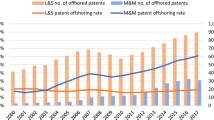Abstract
The study tries to analyze regional technological capabilities, linking technological positions to economic strength of the region. To measure this link, we correlate the EPO patent data with trade data to assess the degree to which technological advantages are translated into comparative advantages for the Flemish region in Belgium. The analysis for Flanders provides some interesting insights. Following the skewed distribution of firms, the technological areas in which Flanders is able to build, a strong position are very specific: printing technology, weaving technology, photography and recently also telecommunications. Weak positions are outspoken in car technology. Linking these strengths and weaknesses in technological areas to economic activity revealed an important mismatch between both. Most of the Flemish patents are in sectors without any comparative advantage, while most of the sectors where Flanders does hold a comparative advantage, like chemicals and pharmaceuticals, do not show strong technological advantages in terms of patents. Given the mismatch that was detected between technological positions and economic advantages, it is of crucial importance to better understand the (missing) links between the various actors in the regional innovation system. The analysis points out two important issues. The large and growing number of foreign applications to Belgian/Flemish inventors and the large number of subsidiaries of foreign firms among Belgian/Flemish applications illustrate the pervasiveness of the foreign dimension in the Belgian/Flemish technological landscape. Also very specific to the Belgian/Flemish situation, is the limited importance of universities or research centers in terms of patenting activities.
Similar content being viewed by others
References
Balassa, An empirical demonstration of classical comparative cost theory,Review of Economics and Statistics, 4((1961).
Debackere, K., D. Rollez,Design capabilities to support innovation strategies, Research Report DTEW (1998).
Gambardella, A., S. Torrisi, Does technological convergence imply convergence in markets? Evidence from the electronics industry,Research Policy, 27, (1998), 445–464.
Griliches, Z., (Ed.)R&D, Patents and Productivity, University of Chicago Press, Chicago (1984).
Griliches, Z., Patent statistics as economic indicators: a survey,Journal of Economic Literature, 28, (1990) 1661–1707.
Grindley, P. C., D. J. Teece, Managing intellectual capital: licensing, and cross-licensing in semiconductors and electronics,California Management Review, 39, 2, (1997) 8–41.
Henderson, R., Underinvestment and incompetence as a response to radical innovation,Rand Journal of Economics, 24, (1993), 465–482.
Henderson, R., Jaffe, A., Trajtenberg M.,The Bayh-Dole Act and trends in university patenting, CEPR Discussion paper Nr 433 (1995).
Levin, R. et al., Appropriating the returns from industrial research and development,Brookings Papers on Economic Activity, 3, (1987) 783–820.
Mazzoleni, R., R. Nelson, Benefits and costs of strong patent protection: a contribution to the current debate,Research Policy, 27, (1998), 273–284.
Merges, R., R. Nelson, On the complex economics of patent scope,Columbia Law Review, 90, (1990), 839–916.
Narin, F., Noma, E., R. Perry, Patents as, indicators of corporate technological strength,Research Policy, 16, (1987), 143–155.
Narin, F., R. P. Rozek, Bibliometric analysis of US pharmaceutical industry research performance,Research Policy, 17, (1988), 139–154.
Narin, F., Linkage between patents and papers: an interim EPO/US comparison,Proceedings of the Sixth Conference of the International Society for Scientometrics and Informetrics, (1997), Jerusalem, Israel.
Patel, P., K. Pavitt, The continuing, widespread importance of improvements in mechanical technologies,Research Policy, 23, (1994), 533–545.
Patel, P., K. Pavitt, The technological competencies of the world's largest firms: complex and path-dependent, but not much variety,Research Policy, 26 (1997), 141–156.
Rappa, M. A., Debackere, K., R. Garud, Technological progress and the duration of contribution spans,Technological Forecasting and Social Change, 42, (1992), 133–145.
Schmoch, U., N. Kirsch,Internationaler Vergleich von Forschung und Entwicklung im Telekommunikationsbereich: Aktualisierung, 1991/92, ISI-reports, (1992).
Schmoch, U., Hinze, S., N. Kirsch,Analysis of the dynamic relationship between technical and economic performances in information and telecommunication sectors, ISI-reports, (1992).
Teece, D. J., Profiting from technological innovation: implications for integration, collaboration, licensing and public policy,Research Policy, 15, (1986) 285–305.
Trajtenberg, M., A penny for your quotes: patent citations and the value of innovations,The Rand Journal of Economics, 21, 1. (1990).
Verspagen, B.,MERIT ISIC-IPC Concordance Table, MERIT Research Memorandum, (1994).
Veugelers, R., B. Cassiman, Make and buy in innovation strategies: Evidence from Belgian manufacturing firms,Research Policy, (1998), to appear.
Author information
Authors and Affiliations
Rights and permissions
About this article
Cite this article
Debackere, K., Luwel, M. & Veugelers, R. Can technology lead to a competitive advantage? A case study of Flanders using european patent data. Scientometrics 44, 379–400 (1999). https://doi.org/10.1007/BF02458486
Received:
Issue Date:
DOI: https://doi.org/10.1007/BF02458486




